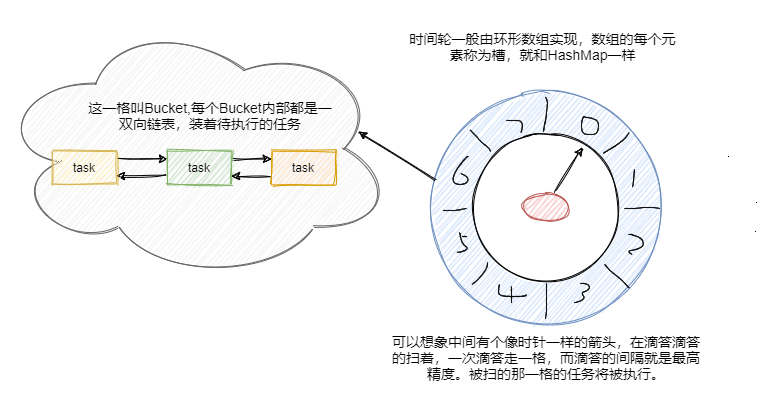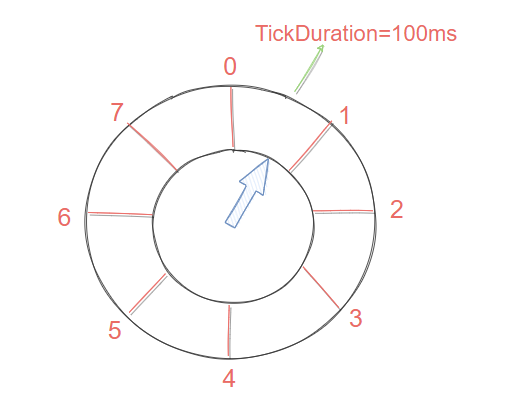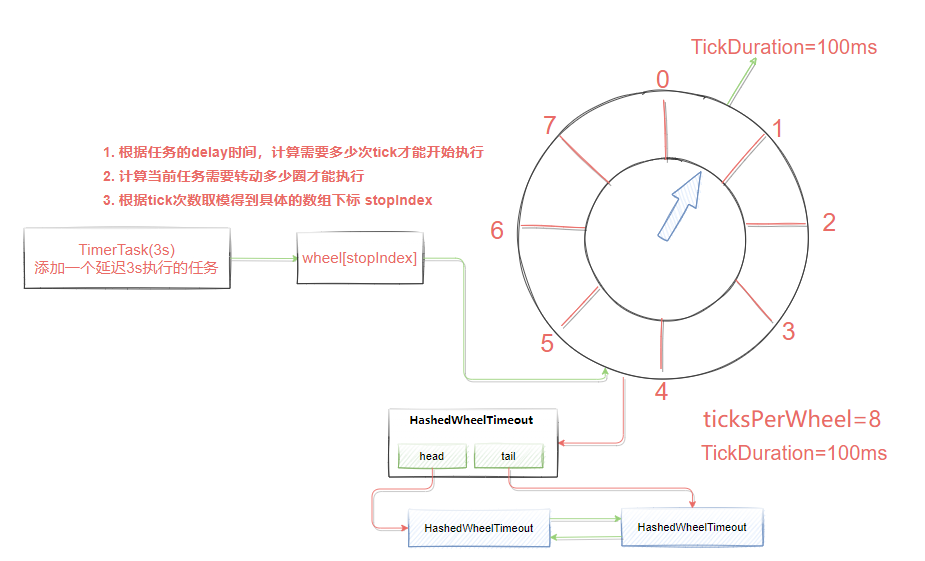

时间轮机制在Redisson分布式锁中的实际应用以及时间轮源码分析
source link: https://my.oschina.net/u/862741/blog/5284263
Go to the source link to view the article. You can view the picture content, updated content and better typesetting reading experience. If the link is broken, please click the button below to view the snapshot at that time.
时间轮机制在Redisson分布式锁中的实际应用以及时间轮源码分析 - 跟着Mic学架构的个人空间 - OSCHINA - 中文开源技术交流社区
本篇文章主要基于Redisson中实现的分布式锁机制继续进行展开,分析Redisson中的时间轮机制。
在前面分析的Redisson的分布式锁实现中,有一个Watch Dog机制来对锁键进行续约,代码如下:
private void renewExpiration() {
ExpirationEntry ee = EXPIRATION_RENEWAL_MAP.get(getEntryName());
if (ee == null) {
return;
}
//用到了时间轮机制
Timeout task = commandExecutor.getConnectionManager().newTimeout(new TimerTask() {
//添加一个任务到时间轮
//省略部分代码....
}, internalLockLeaseTime / 3, TimeUnit.MILLISECONDS);//每次间隔租期的1/3时间执行
ee.setTimeout(task);
}
实际上是构建了一个TimerTask,通过timer.newTimeout(task, delay, unit);添加到时间轮中。
@Override
public Timeout newTimeout(TimerTask task, long delay, TimeUnit unit) {
try {
//delay: 延迟执行时间
//unit: 延迟执行时间单位
return timer.newTimeout(task, delay, unit);
} catch (IllegalStateException e) {
if (isShuttingDown()) {
return DUMMY_TIMEOUT;
}
throw e;
}
}
private HashedWheelTimer timer;
先来了解一下什么是时间轮
时间轮这个技术其实出来很久了,在kafka、zookeeper等技术中都有时间轮使用的方式。我第一次听这个概念,是当时我一个朋友在拼多多,负责整体架构设计时需要考虑到超时订单的自动关单,而订单交易量又特别多,直接去轮询数据的效率有点低,所以当时沟通下来聊到了时间轮这个东西。什么是时间轮呢?
简单来说: 时间轮是一种高效利用线程资源进行批量化调度的一种调度模型。把大批量的调度任务全部绑定到同一个调度器上,使用这一个调度器来进行所有任务的管理、触发、以及运行。
所以时间轮的模型能够高效管理各种延时任务、周期任务、通知任务。 以后大家在工作中遇到类似的功能,可以采用时间轮机制。
如图3-11,时间轮,从图片上来看,就和手表的表圈是一样,所以称为时间轮,是因为它是以时间作为刻度组成的一个环形队列,这个环形队列采用数组来实现,数组的每个元素称为槽,每个槽可以放一个定时任务列表,叫HashedWheelBucket,它是一个双向链表,量表的每一项表示一个定时任务项(HashedWhellTimeout),其中封装了真正的定时任务TimerTask。
时间轮是由多个时间格组成,下图中有8个时间格,每个时间格代表当前时间轮的基本时间跨度(tickDuration),其中时间轮的时间格的个数是固定的。
在下图中,有8个时间格(槽),假设每个时间格的单位为1s,那么整个时间轮走完一圈需要8s钟。每秒钟指针会沿着顺时针方向移动一个,这个单位可以设置,比如以秒为单位,可以以一小时为单位,这个单位可以代表时间精度。通过指针移动,来获得每个时间格中的任务列表,然后遍历这一个时间格中的双向链表来执行任务,以此循环。

<center>图3-11</center>
时间轮的使用
这里使用的时间轮是Netty这个包中提供的,使用方法比较简单。
- 先构建一个HashedWheelTimer时间轮。
- tickDuration: 100 ,表示每个时间格代表当前时间轮的基本时间跨度,这里是100ms,也就是指针100ms跳动一次,每次跳动一个窗格
- ticksPerWheel:1024,表示时间轮上一共有多少个窗格,分配的窗格越多,占用内存空间就越大
- leakDetection:是否开启内存泄漏检测。
- maxPendingTimeouts[可选参数],最大允许等待的任务数,默认没有限制。
- 通过newTimeout()把需要延迟执行的任务添加到时间轮中
@RestController
public class RedissonController {
@Autowired
RedissonClient redissonClient;
HashedWheelTimer hashedWheelTimer= new HashedWheelTimer(new DefaultThreadFactory("demo-timer"), 100, TimeUnit.MILLISECONDS, 1024, false);
/**
* 添加延迟任务
* @param delay
*/
@GetMapping("/{delay}")
public void tick(@PathVariable("delay")Long delay){
System.out.println("currentDate:"+new Date());
hashedWheelTimer.newTimeout(timeout -> {
System.out.println("executeDate:"+new Date());
}, delay, TimeUnit.SECONDS);
}
}
时间轮的原理解析
时间轮的整体原理,分为几个部分。
-
创建时间轮
时间轮本质上是一个环状数组,比如我们初始化时间轮时:ticksPerWheel=8,那么意味着这个环状数组的长度是8,如图3-12所示。
HashedWheelBucket[] wheel = new HashedWheelBucket[ticksPerWheel];
<center>图3-12</center>
-
添加任务,如图3-13所示
-
当通过newTimeout()方法添加一个延迟任务时,该任务首先会加入到一个阻塞队列中中。
-
然后会有一个定时任务从该队列获取任务,添加到时间轮的指定位置,计算方法如下。
//当前任务的开始执行时间除以每个窗口的时间间隔,得到一个calculated值(表示需要经过多少tick,指针没跳动一个窗格,tick会递增),单位为nanos(微毫秒) long calculated = timeout.deadline / tickDuration; //计算当前任务需要在时间轮中经历的圈数,因为当前任务执行时间有可能大于完整一圈的时间,所以需要计算经过几圈之后才能执行该任务。 timeout.remainingRounds = (calculated - tick) / wheel.length; //取最大的一个tick,有可能当前任务在队列中已经过了执行时间,这种情况下直接用calculated这个值就没意义了。 final long ticks = Math.max(calculated, tick); // Ensure we don't schedule for past. int stopIndex = (int) (ticks & mask); //通过ticks取模mask,得到一个下标 HashedWheelBucket bucket = wheel[stopIndex]; //把任务添加到指定数组下标位置
<center>图3-13</center>
-
-
Worker线程按照每次间隔时间转动后,得到该时间窗格中的任务链表,然后从链表的head开始逐个取出任务,有两个判断条件
- 当前任务需要转动的圈数为0,表示任务是当前圈开始执行
- 当前任务达到了delay时间,也就是
timeout.deadline <= deadline - 最终调用timeout.expire()方法执行任务。
public void expireTimeouts(long deadline) { HashedWheelTimeout timeout = head; // process all timeouts while (timeout != null) { HashedWheelTimeout next = timeout.next; if (timeout.remainingRounds <= 0) { next = remove(timeout); if (timeout.deadline <= deadline) { timeout.expire(); } else { // The timeout was placed into a wrong slot. This should never happen. throw new IllegalStateException(String.format( "timeout.deadline (%d) > deadline (%d)", timeout.deadline, deadline)); } } else if (timeout.isCancelled()) { next = remove(timeout); } else { timeout.remainingRounds --; } timeout = next; } }
时间轮的源码分析
HashedWheelTimer的构造
- 调用createWheel创建一个时间轮,时间轮数组一定是2的幂次方,比如传入的ticksPerWheel=6,那么初始化的wheel长度一定是8,这样是便于时间格的计算。
- tickDuration,表示时间轮的跨度,代表每个时间格的时间精度,以纳秒的方式来表现。
- 把工作线程Worker封装成WorkerThread,从名字可以知道,它就是最终那个负责干活的线程。
public HashedWheelTimer(
ThreadFactory threadFactory,
long tickDuration, TimeUnit unit, int ticksPerWheel,
long maxPendingTimeouts) {
// 创建时间轮基本的数据结构,一个数组。长度为不小于ticksPerWheel的最小2的n次方
wheel = createWheel(ticksPerWheel);
// 这是一个标示符,用来快速计算任务应该呆的格子。
// 我们知道,给定一个deadline的定时任务,其应该呆的格子=deadline%wheel.length.但是%操作是个相对耗时的操作,所以使用一种变通的位运算代替:
// 因为一圈的长度为2的n次方,mask = 2^n-1后低位将全部是1,然后deadline&mast == deadline%wheel.length
// java中的HashMap在进行hash之后,进行index的hash寻址寻址的算法也是和这个一样的
mask = wheel.length - 1;
//时间轮的基本时间跨度,(tickDuration传入是1的话,这里会转换成1000000)
this.tickDuration = unit.toNanos(tickDuration);
// 校验是否存在溢出。即指针转动的时间间隔不能太长而导致tickDuration*wheel.length>Long.MAX_VALUE
if (this.tickDuration >= Long.MAX_VALUE / wheel.length) {
throw new IllegalArgumentException(String.format(
"tickDuration: %d (expected: 0 < tickDuration in nanos < %d",
tickDuration, Long.MAX_VALUE / wheel.length));
}
//把worker包装成thread
workerThread = threadFactory.newThread(worker);
this.maxPendingTimeouts = maxPendingTimeouts;
//如果HashedWheelTimer实例太多,那么就会打印一个error日志
if (INSTANCE_COUNTER.incrementAndGet() > INSTANCE_COUNT_LIMIT &&
WARNED_TOO_MANY_INSTANCES.compareAndSet(false, true)) {
reportTooManyInstances();
}
}
- 对传入的ticksPerWheel进行整形
- 初始化固定长度的HashedWheelBucket
private static HashedWheelBucket[] createWheel(int ticksPerWheel) {
if (ticksPerWheel <= 0) {
throw new IllegalArgumentException(
"ticksPerWheel must be greater than 0: " + ticksPerWheel);
}
if (ticksPerWheel > 1073741824) {
throw new IllegalArgumentException(
"ticksPerWheel may not be greater than 2^30: " + ticksPerWheel);
}
//对传入的时间轮大小进行整形,整形成2的幂次方
ticksPerWheel = normalizeTicksPerWheel(ticksPerWheel);
//初始化一个固定长度的Bucket数组
HashedWheelBucket[] wheel = new HashedWheelBucket[ticksPerWheel];
for (int i = 0; i < wheel.length; i++) {
wheel[i] = new HashedWheelBucket();
}
return wheel;
}
添加任务到时间轮
完成时间轮的初始化之后,并没有去启动时间轮,继续看FailbackClusterInvoker中的代码。
构建了一个RetryTimerTask,也就是一个重试的定时任务,接着把这个任务通过newTimeout加入到时间轮中,其中
- retryTimerTask,表示具体的重试任务
- RETRY_FAILED_PERIOD , 表示重试间隔时间,默认为5s
RetryTimerTask retryTimerTask = new RetryTimerTask(loadbalance, invocation, invokers, lastInvoker, retries, RETRY_FAILED_PERIOD);
failTimer.newTimeout(retryTimerTask, RETRY_FAILED_PERIOD, TimeUnit.SECONDS);
调用newTimeout方法,把任务添加进来。
public Timeout newTimeout(TimerTask task, long delay, TimeUnit unit) {
if (task == null) {
throw new NullPointerException("task");
}
if (unit == null) {
throw new NullPointerException("unit");
}
//统计任务个数
long pendingTimeoutsCount = pendingTimeouts.incrementAndGet();
//判断最大任务数量是否超过限制
if (maxPendingTimeouts > 0 && pendingTimeoutsCount > maxPendingTimeouts) {
pendingTimeouts.decrementAndGet();
throw new RejectedExecutionException("Number of pending timeouts ("
+ pendingTimeoutsCount + ") is greater than or equal to maximum allowed pending "
+ "timeouts (" + maxPendingTimeouts + ")");
}
//如果时间轮没有启动,则通过start方法进行启动
start();
// Add the timeout to the timeout queue which will be processed on the next tick.
// During processing all the queued HashedWheelTimeouts will be added to the correct HashedWheelBucket.
//计算任务的延迟时间,通过当前的时间+当前任务执行的延迟时间-时间轮启动的时间。
long deadline = System.nanoTime() + unit.toNanos(delay) - startTime;
//在delay为正数的情况下,deadline是不可能为负数
//如果为负数,那么说明超过了long的最大值
if (delay > 0 && deadline < 0) {
deadline = Long.MAX_VALUE;
}
//创建一个Timeout任务,理论上来说,这个任务应该要加入到时间轮的时间格子中,但是这里并不是先添加到时间格,而是先
//加入到一个阻塞队列,然后等到时间轮执行到下一个格子时,再从队列中取出最多100000个任务添加到指定的时间格(槽)中。
HashedWheelTimeout timeout = new HashedWheelTimeout(this, task, deadline);
timeouts.add(timeout);
return timeout;
}
start
任务添加到阻塞队列之后,我们再来看启动方法
start方法会根据当前的workerState状态来启动时间轮。并且用了startTimeInitialized来控制线程的运行,如果workerThread没有启动起来,那么newTimeout方法会一直阻塞在运行start方法中。如果不阻塞,newTimeout方法会获取不到startTime。
public void start() {
//workerState一开始的时候是0(WORKER_STATE_INIT),然后才会设置为1(WORKER_STATE_STARTED)
switch (WORKER_STATE_UPDATER.get(this)) {
case WORKER_STATE_INIT:
if (WORKER_STATE_UPDATER.compareAndSet(this, WORKER_STATE_INIT, WORKER_STATE_STARTED)) {
workerThread.start();
}
break;
case WORKER_STATE_STARTED:
break;
case WORKER_STATE_SHUTDOWN:
throw new IllegalStateException("cannot be started once stopped");
default:
throw new Error("Invalid WorkerState");
}
// 等待worker线程初始化时间轮的启动时间
while (startTime == 0) {
try {
//这里使用countDownLauch来确保调度的线程已经被启动
startTimeInitialized.await();
} catch (InterruptedException ignore) {
// Ignore - it will be ready very soon.
}
}
}
启动时间轮
调用start()方法, 会调用workerThread.start();来启动一个工作线程,这个工作线程是在构造方法中初始化的,包装的是一个Worker内部线程类。
所以直接进入到Worker这个类的run方法,了解下它的设计逻辑
public void run() {
// 初始化startTime,表示时间轮的启动时间
startTime = System.nanoTime();
if (startTime == 0) {
// We use 0 as an indicator for the uninitialized value here, so make sure it's not 0 when initialized.
startTime = 1;
}
// 唤醒被阻塞的start()方法。
startTimeInitialized.countDown();
do {
//返回每tick一次的时间间隔
final long deadline = waitForNextTick();
if (deadline > 0) {
//计算时间轮的槽位
int idx = (int) (tick & mask);
//移除掉CancelledTask
processCancelledTasks();
//得到当前指针位置的时间槽
HashedWheelBucket bucket =
wheel[idx];
//将newTimeout()方法中加入到待处理定时任务队列中的任务加入到指定的格子中
transferTimeoutsToBuckets();
//运行目前指针指向的槽中的bucket链表中的任务
bucket.expireTimeouts(deadline);
tick++;
}
} while (WORKER_STATE_UPDATER.get(HashedWheelTimer.this) == WORKER_STATE_STARTED);
//如果Worker_State一只是started状态,就一直循环
// Fill the unprocessedTimeouts so we can return them from stop() method.
for (HashedWheelBucket bucket : wheel) {
bucket.clearTimeouts(unprocessedTimeouts); //清除时间轮中不需要处理的任务
}
for (; ; ) {
//遍历任务队列,发现如果有任务被取消,则添加到unprocessedTimeouts,也就是不需要处理的队列中。
HashedWheelTimeout timeout = timeouts.poll();
if (timeout == null) {
break;
}
if (!timeout.isCancelled()) {
unprocessedTimeouts.add(timeout);
}
}
//处理被取消的任务.
processCancelledTasks();
}
时间轮指针跳动
这个方法的主要作用就是返回下一个指针指向的时间间隔,然后进行sleep操作。
大家可以想象一下,一个钟表上秒与秒之间是有时间间隔的,那么waitForNextTick就是根据当前时间计算出跳动到下个时间的时间间隔,然后进行sleep,然后再返回当前时间距离时间轮启动时间的时间间隔。
说得再直白一点:,假设当前的tickDuration的间隔是1s,tick默认=0, 此时第一次进来,得到的deadline=1,也就是下一次跳动的时间间隔是1s。假设当前处于
private long waitForNextTick() {
//tick表示总的tick数
//tickDuration表示每个时间格的跨度,所以deadline返回的是下一次时间轮指针跳动的时间
long deadline = tickDuration * (tick + 1);
for (; ; ) {
//计算当前时间距离启动时间的时间间隔
final long currentTime = System.nanoTime() - startTime;
//通过下一次指针跳动的延迟时间距离当前时间的差额,这个作为sleep时间使用。
// 其实线程是以睡眠一定的时候再来执行下一个ticket的任务的
long sleepTimeMs = (deadline - currentTime + 999999) / 1000000;
//sleepTimeMs小于零表示走到了下一个时间槽位置
if (sleepTimeMs <= 0) {
if (currentTime == Long.MIN_VALUE) {
return -Long.MAX_VALUE;
} else {
return currentTime;
}
}
if (isWindows()) {
sleepTimeMs = sleepTimeMs / 10 * 10;
}
//进入到这里进行sleep,表示当前时间距离下一次tick时间还有一段距离,需要sleep。
try {
Thread.sleep(sleepTimeMs);
} catch (InterruptedException ignored) {
if (WORKER_STATE_UPDATER.get(HashedWheelTimer.this) == WORKER_STATE_SHUTDOWN) {
return Long.MIN_VALUE;
}
}
}
}
transferTimeoutsToBuckets
转移任务到时间轮中,前面我们讲过,任务添加进来时,是先放入到阻塞队列。
而在现在这个方法中,就是把阻塞队列中的数据转移到时间轮的指定位置。
在这个转移方法中,写死了一个循环,每次都只转移10万个任务。
然后根据HashedWheelTimeout的deadline延迟时间计算出时间轮需要运行多少次才能运行当前的任务,如果当前的任务延迟时间大于时间轮跑一圈所需要的时间,那么就计算需要跑几圈才能到这个任务运行。
最后计算出该任务在时间轮中的槽位,添加到时间轮的链表中。
private void transferTimeoutsToBuckets() {
// 循环100000次,也就是每次转移10w个任务
for (int i = 0; i < 100000; i++) {
//从阻塞队列中获得具体的任务
HashedWheelTimeout timeout = timeouts.poll();
if (timeout == null) {
// all processed
break;
}
if (timeout.state() == HashedWheelTimeout.ST_CANCELLED) {
// Was cancelled in the meantime.
continue;
}
//计算tick次数,deadline表示当前任务的延迟时间,tickDuration表示时间槽的间隔,两者相除就可以计算当前任务需要tick几次才能被执行
long calculated = timeout.deadline / tickDuration;
// 计算剩余的轮数, 只有 timer 走够轮数, 并且到达了 task 所在的 slot, task 才会过期.(被执行)
timeout.remainingRounds = (calculated - tick) / wheel.length;
//如果任务在timeouts队列里面放久了, 以至于已经过了执行时间, 这个时候就使用当前tick, 也就是放到当前bucket, 此方法调用完后就会被执行
final long ticks = Math.max(calculated, tick);
// 算出任务应该插入的 wheel 的 slot, stopIndex = tick 次数 & mask, mask = wheel.length - 1
int stopIndex = (int) (ticks & mask);
//把timeout任务插入到指定的bucket链中。
HashedWheelBucket bucket = wheel[stopIndex];
bucket.addTimeout(timeout);
}
}
运行时间轮中的任务
当指针跳动到某一个时间槽中时,会就触发这个槽中的任务的执行。该功能是通过expireTimeouts来实现
这个方法的主要作用是: 过期并执行格子中到期的任务。也就是当tick进入到指定格子时,worker线程会调用这个方法
HashedWheelBucket是一个链表,所以我们需要从head节点往下进行遍历。如果链表没有遍历到链表尾部那么就继续往下遍历。
获取的timeout节点节点,如果剩余轮数remainingRounds大于0,那么就说明要到下一圈才能运行,所以将剩余轮数减一;
如果当前剩余轮数小于等于零了,那么就将当前节点从bucket链表中移除,并判断一下当前的时间是否大于timeout的延迟时间,如果是则调用timeout的expire执行任务。
void expireTimeouts(long deadline) {
HashedWheelTimeout timeout = head;
// 遍历当前时间槽中的所有任务
while (timeout != null) {
HashedWheelTimeout next = timeout.next;
//如果当前任务要被执行,那么remainingRounds应该小于或者等于0
if (timeout.remainingRounds <= 0) {
//从bucket链表中移除当前timeout,并返回链表中下一个timeout
next = remove(timeout);
//如果timeout的时间小于当前的时间,那么就调用expire执行task
if (timeout.deadline <= deadline) {
timeout.expire();
} else {
//不可能发生的情况,就是说round已经为0了,deadline却>当前槽的deadline
// The timeout was placed into a wrong slot. This should never happen.
throw new IllegalStateException(String.format(
"timeout.deadline (%d) > deadline (%d)", timeout.deadline, deadline));
}
} else if (timeout.isCancelled()) {
next = remove(timeout);
} else {
//因为当前的槽位已经过了,说明已经走了一圈了,把轮数减一
timeout.remainingRounds--;
}
//把指针放置到下一个timeout
timeout = next;
}
}
关注[跟着Mic学架构]公众号,获取更多精品原创
Recommend
About Joyk
Aggregate valuable and interesting links.
Joyk means Joy of geeK